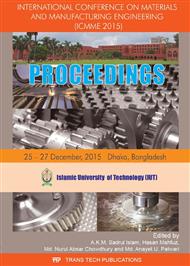p.129
p.134
p.140
p.146
p.152
p.158
p.165
p.173
p.179
Green Synthesis and Characterization of Silver Nanoparticles by Using Aloe Vera Leaf Extract to Study the Effects of Synthesis Parameters
Abstract:
In this research silver nanoparticles were synthesized by reducing silver nitrate solution using aloe vera leaf extract as reducing agent. The synthesized nanoparticles had been characterized and the effects of different parameters of synthesis had been evaluated. Silver nanoparticles began to form just after reaction and the whole reduction reaction was completed within 3 hours. The color changed from transparent to dark brown of the aqueous salt solution. Later the nanoparticles were separated out from the mixture by ultra-centrifugation. Here the effects of water bath temperature, the effects of heating time at that certain temperature and the effects of changing concentration of silver nitrate on the size of the synthesized nanoparticles was studied. The particle size and morphology of the synthesized silver nanoparticles were identified by SEM analysis. It was found to be 12-200 nm in different parameters (12-25 nm at the best condition) and spherical in shape. It was also found that the size of silver nanoparticles increased with increasing water bath temperature, increasing heating time and increasing silver nitrate concentration. Energy dispersive X-ray spectroscopy was used to confirm that the nanoparticle suspension contains nothing but metallic silver. It was found that 70% of elemental silver nanoparticles were present.
Info:
Periodical:
Pages:
179-184
Citation:
Online since:
December 2016
Keywords:
Price:
Сopyright:
© 2017 Trans Tech Publications Ltd. All Rights Reserved
Share:
Citation:


